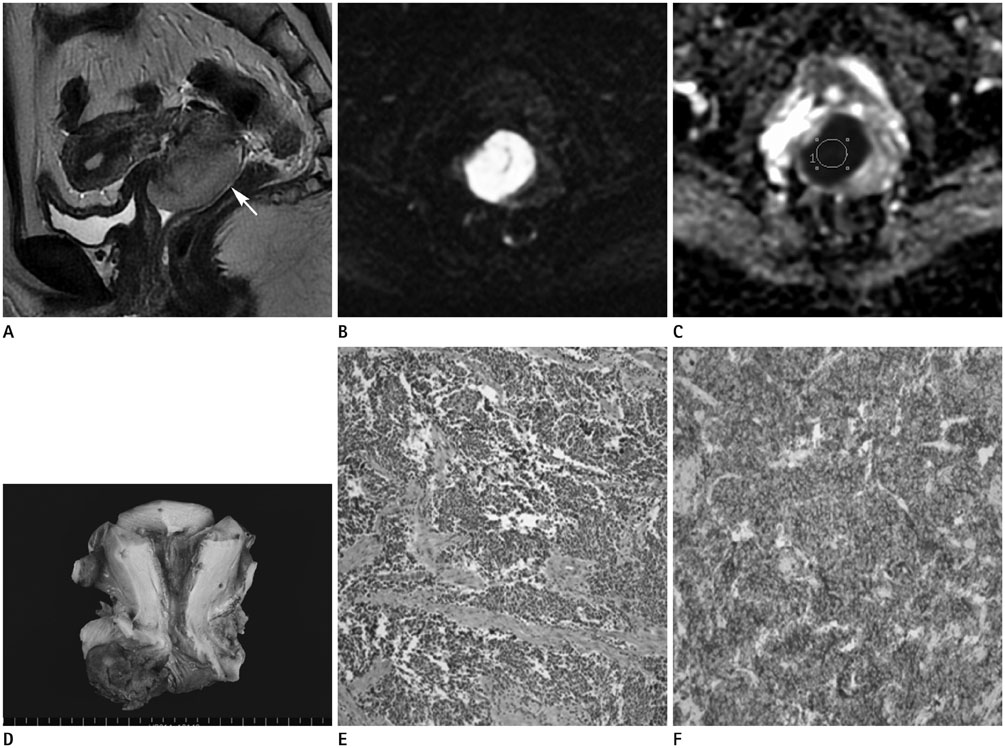J Korean Soc Radiol.
2015 Oct;73(4):274-278. 10.3348/jksr.2015.73.4.274.
MRI Findings of Small Cell Neuroendocrine Carcinoma of the Uterine Cervix: A Case Report
- Affiliations
-
- 1Department of Radiology, Soonchunhyang University College of Medicine, Bucheon Hospital, Bucheon, Korea. rad1995@schmc.ac.kr
- 2Department of Pathology, Soonchunhyang University College of Medicine, Bucheon Hospital, Bucheon, Korea.
- KMID: 2068720
- DOI: http://doi.org/10.3348/jksr.2015.73.4.274
Abstract
- Small cell neuroendocrine carcinoma of the uterine cervix is a rare primary neoplasm, accounting for less than 5% of all uterine cervical cancers. The tumor is known to have an aggressive behavior and poor prognosis. In this article, we present the MRI findings of 5 cases of pathologically-proven small cell neuroendocrine carcinoma of the uterine cervix, including diffusion-weighted images.
MeSH Terms
Figure
Reference
-
1. Klimstra DS, Modlin IR, Coppola D, Lloyd RV, Suster S. The pathologic classification of neuroendocrine tumors: a review of nomenclature, grading, and staging systems. Pancreas. 2010; 39:707–712.2. Viswanathan AN, Deavers MT, Jhingran A, Ramirez PT, Levenback C, Eifel PJ. Small cell neuroendocrine carcinoma of the cervix: outcome and patterns of recurrence. Gynecol Oncol. 2004; 93:27–33.3. Abeler VM, Holm R, Nesland JM, Kjørstad KE. Small cell carcinoma of the cervix. A clinicopathologic study of 26 patients. Cancer. 1994; 73:672–667.4. Kim do Y, Yun HJ, Lee YS, Lee HN, Kim CJ. Small cell neuroendocrine carcinoma of the uterine cervix presenting with syndrome of inappropriate antidiuretic hormone secretion. Obstet Gynecol Sci. 2013; 56:420–425.5. Yang DH, Kim JK, Kim KW, Bae SJ, Kim KH, Cho KS. MRI of small cell carcinoma of the uterine cervix with pathologic correlation. AJR Am J Roentgenol. 2004; 182:1255–1258.6. van Nagell JR Jr, Powell DE, Gallion HH, Elliott DG, Donaldson ES, Carpenter AE, et al. Small cell carcinoma of the uterine cervix. Cancer. 1988; 62:1586–1593.7. Rashed MM, Bekele A. Neuroendocrine differentiation in a case of cervical cancer. Pan Afr Med J. 2010; 6:4.8. Kuang F, Ren J, Zhong Q, Liyuan F, Huan Y, Chen Z. The value of apparent diffusion coefficient in the assessment of cervical cancer. Eur Radiol. 2013; 23:1050–1058.
- Full Text Links
- Actions
-
Cited
- CITED
-
- Close
- Share
- Similar articles
-
- A Case of Mixed Small and Large Cell Neuroendocrine Carcinoma of the Uterine Cervix
- Small cell neuroendocrine carcinoma of the uterine cervix presenting with syndrome of inappropriate antidiuretic hormone secretion
- Skin Metastasis of Neuroendocrine Carcinoma Arising in the Uterine Cervix
- Metastatic small cell neuroendocrine carcinoma of the liver from the uterine cervix
- Small Cell Neuroendocrine Carcinoma of the Uterine Cervix Mimicking Cervical Lymphoma: A Case Report


